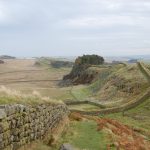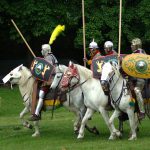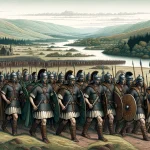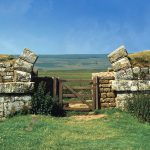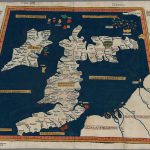Alchester Fort (Bicester)
Minor Settlement
The Roman settlement of Alchester stands at the junction of five roads. The second century civil defences enclose an area of around forty-five hectares, its interior streets based on a rough grid-pattern are unusual in Britain. Extra-mural occupation is indicated by surface finds of building materials and pottery. A number of excavations undertaken in the interior of the enclosure over the years have revealed several periods of construction, with stone buildings gradually replacing earlier ones of timber. The attested occupation period from these digs was from the mid-first to the fourth centuries.
The site of a suspected bath-house, where tessalated floors and a hypocaust were uncovered in 1766, lies about one hundred metres outside the western defences. Hussey in 1841 reported the finding of a tessalated pavement within the defences, immediately west of the east gate. A cemetery was uncovered during work on the Oxford-Bletchley railway line in 1848, lying fifty metres east of the south-eastern angle of the towns defences. Twenty-eight undated inhumation burials were reported at this time. Aerial photographs taken in the 1960’s revealed several buildings and perhaps a temple, lying to the south-west of the principal road junction.
Classical References to Alchester
Alchester does not appear in any of the classical geographies, so unfortunately, the Roman name of the town is not known. However, Eilert Ekwall contended that it appears as Alavna in the Ravenna Cosmography, with the addition of the Old English ceaster to signify a Roman fort.
Alchester was originally named Bernecestre, meaning ‘fort of warriors’ and dating back to around 600 AD.
The Claudian Vexillation Fortress Wendlebury, Alchester (SP570203)
Claudio-Neronian Samian ware had been recovered from excavation trenches within the enclosed area of the town, and two Flavian ditches infilled with turf were thought to be indicative of the levelling of a fort rampart. Discovered on aerial photographs in 1998, a large fortress was seen to underlie part of the Roman town. Excavations on the site conducted recently by a team from the Leicester University Archaeological Department working under the supervision of Dr. Eberhard Sauer from Keble College Oxford, have confirmed the presence of a Claudian vexillation fortress.
Covering an area of around 26 acres with an annexe of an extra 10 acres (10.5ha fortress, 4ha annexe), the primary enclosure is sufficient to house at least half a legion, together with perhaps a couple of cavalry regiments. The fortress was defended by a triple-ditch system; the inner ditch had a classic Roman military V-shaped profile, the central ditch was shallow and flat-bottomed, and may have contained pointed stakes (cippae), and the outer ditch had been cut with an almost vertical outer face and a shallow inner face, giving an irregular profile known as a fossa punica, which was set within easy javelin range from the fortresses rampart walk. Evidence of a parade ground was also discovered outside the defences of the fort.
Dendrochronological dating performed on samples of waterlogged construction timbers from the gateposts of the western porta praetoria showed that the trees used in these defenses were felled sometime between October 44AD and March 45AD; the earlier of these dates is only about a year and a half after the initial Claudian invasion of Britain in the summer of 43AD.
The Alchester Garrison
The discovery of an early-period cavalry harness clip of bronze would seem to confirm the theory that the fortress held a contingent of auxiliary cavalry. Further evidence confirming the presence of the Roman military at Alchester has appeared in the shape of a piece of Roman scale armour. Four small plates of bronze were found immediately outside the north gate of the town, joined together through perforations along their edges by a number of small bronze links. This type of scale armour was used throughout the Roman army, by legionaries and auxiliaries, common soldiers and officers, so we are unable to determine from the armour alone what type of unit was stationed at the fort. The surface of the plates showed evidence that they had once been covered with a coating of tin, so the armour probably did not belong to a high-ranking officer who would have preferred a silver plating, neither would it have been the property of an ordinary soldier who generally spent his salary on more earthly items. This mail was probably worn by a middle-ranking officer, either a legionary centurion, or possibly an optio in a cavalry unit.
In conclusion, the Alchester fortress was most likely garrisoned by perhaps four or five legionary cohorts, quite possibly half of Legio XIV Gemina, together with at least one auxiliary cavalry ala or perhaps cohors equitata, which position, if the presence of the Fourteenth Legion is accepted, may have been filled by one (or more) of the eight regiments of Batavi which are thought to have been attached to the Fourteenth.
References for Alchester / Bicester
- Oxford Dictionary of English Place-Names by A.D. Mills (Oxford 1998);
- Roman Britain by Peter Salway (Oxford 1981);
- Air Reconnaissance of Southern Britain by J.K. St. Joseph in J.R.S. xliii (1953)
Roman Roads near Alchester / Bicester
NNE (20) to Lactodvrvm (Towcester, Northamptonshire) Probable road: NW (16) to Lower Lea WSW (19) to Asthall (Oxfordshire) ESE (25) to North Chvrch (Hertfordshire) S (18) to Dorchester On Thames (Oxfordshire) ESE (13) to Fleet Marston WSW (11) to North Leigh Road: S (10) to Shotover (Oxfordshire) Akeman Street: WSW (14) to Wilcote
Sites near Alchester Fort (Bicester)
- Alchester (Bicester) Vicus (0)
Vicus - Akeman Street (3 km)
Roman Road - Islip Roman Villa (8 km)
Villa - Woodeaton Temple (9 km)
Temple Or Shrine - Shotover (14 km)
Settlement - North Oxford (15 km)
Minor Settlement and Pottery - Ditchley Roman Villa (17 km)
Villa - North Leigh Villa (18 km)
Villa - Bourton Grounds Temple (20 km)
Temple Or Shrine - Fleet Marston Roman Settlement (20 km)
Minor Settlement
